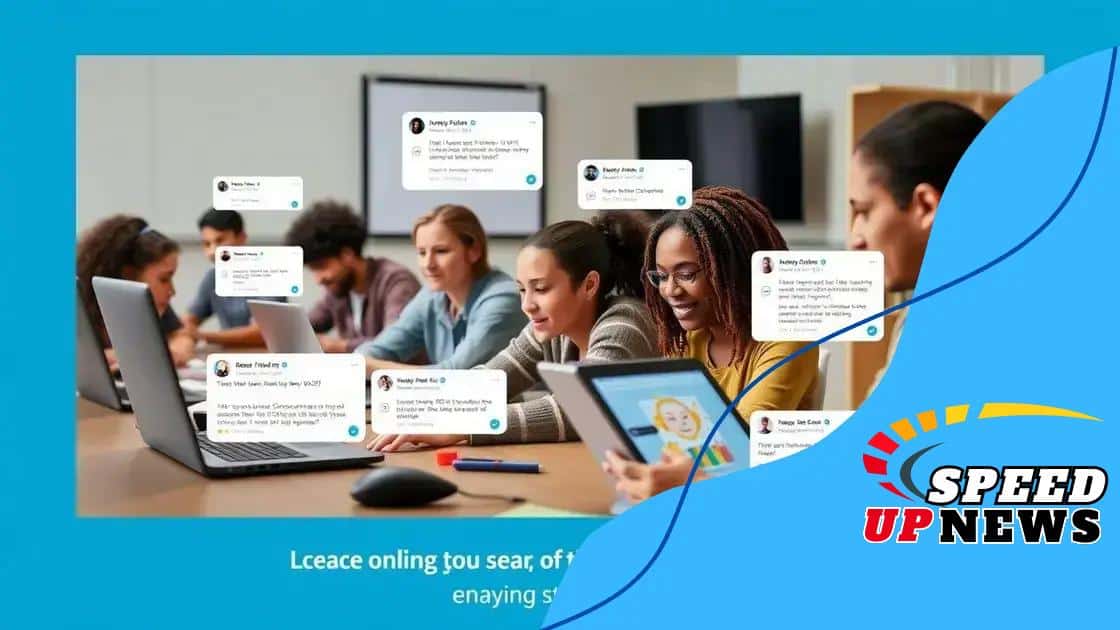Remote learning solutions for K-12 education that work

Remote learning solutions for K-12 education utilize technology tools and best practices to engage students effectively, providing flexible, interactive, and collaborative learning environments.
Are you aware that remote learning solutions for K-12 education are reshaping how students learn? With the rise of online platforms, it’s worth exploring how these innovative methods can enhance education.
Understanding remote learning in K-12
Understanding remote learning in K-12 is essential for educators and students alike. With the shift to online platforms, many have questions about how this new method works and what it means for education.
At its core, remote learning offers students the ability to access education from anywhere. This approach means that teachers can reach their students in new and exciting ways. Some of the most common delivery methods include:
Live Classes
These are scheduled sessions where students participate in real-time with their teachers. Using video conferencing tools, educators can simulate a traditional classroom environment.
Recorded Lessons
Students can revisit lessons at their convenience by watching pre-recorded classes. This flexibility helps them learn at their own pace.
- Access to resources anytime
- Ability to review complex topics
- Learning on one’s own schedule
Additionally, remote learning incorporates interactive tools. For example, quizzes and discussion threads encourage engagement and ensure students stay involved. Using forums for questions not only builds community but also helps clear up misunderstandings.
However, it’s important to know that remote learning presents challenges too. Connectivity issues and lack of motivation can hinder a student’s learning experience. Schools and families should work together to find solutions that support students’ needs.
Effective communication with parents is vital in overseeing students’ progress and addressing their concerns. Ultimately, understanding remote learning in K-12 empowers educators and parents to cultivate a productive learning environment.
Benefits of virtual classrooms
Virtual classrooms offer numerous benefits that enhance the educational experience for students and teachers alike. By providing an interactive platform, these classrooms facilitate learning in ways that traditional settings may not.
One significant advantage is the flexibility that virtual classrooms provide. Students can learn from anywhere, breaking geographical barriers. This means that whether a student is at home or traveling, education is always within reach. They can also access materials and resources at their convenience, allowing for personalized learning paces.
Enhanced Engagement
Virtual classrooms often use various multimedia tools, making lessons more engaging than standard lectures. These tools include:
- Interactive whiteboards for collaborative learning
- Live polls to gauge understanding
- Video discussions that promote communication
This dynamic learning environment helps to keep students interested and motivated. When students interact with their peers and teachers in real-time, they feel more connected to the material.
Cost-Effective Options
Another key benefit is the cost-effectiveness of virtual classrooms. Schools can save on physical infrastructure, maintenance, and resources. For families, this can translate to lower tuition costs and the elimination of commuting expenses.
Additionally, online resources can often be more affordable than traditional textbooks. With digital libraries and open educational resources, students can access high-quality materials for little to no cost, enhancing their learning experience.
Adopting virtual classrooms is not just about convenience; it’s about preparing students for the future. As technology continues to evolve, having experience with virtual learning environments equips students with essential skills such as self-discipline, time management, and digital literacy.
Engaging students in online environments

Engaging students in online environments is crucial for effective learning. With the rise of remote education, educators need innovative strategies to keep students involved. When students are engaged, they are more likely to participate actively and retain information better.
Interactive Learning Tools
Utilizing interactive learning tools can significantly enhance student engagement. These tools foster communication and collaboration among students and teachers. Some popular options include:
- Discussion boards for sharing ideas
- Virtual breakout rooms for small group work
- Interactive quizzes and polls during lessons
These resources provide opportunities for students to express their thoughts and connect with peers, making the learning experience more lively and dynamic.
Create a Community
Building a sense of community is vital in online classrooms. When students feel connected to their classmates, they are more likely to engage. Regular check-ins, team projects, and collaborative assignments help foster this connection.
Teachers can also encourage students to share their interests and experiences to create a more inclusive atmosphere. As a result, students may feel more comfortable participating and sharing their opinions.
Additionally, positive reinforcement can play a significant role in student motivation. Recognizing students’ efforts and achievements boosts their confidence and inspires them to be more engaged in their learning. Providing feedback, whether through grades or verbal praise, helps students understand their progress.
As online learning continues to evolve, effective engagement strategies will remain essential. Adapting to the needs of students and being open to new approaches will keep online environments thriving and beneficial for all learners.
Technology tools for remote education
Technology tools for remote education are essential for creating an effective learning environment. With the right tools, students can interact, collaborate, and learn more efficiently from anywhere.
Essential Tools for Learning
There are a variety of technology tools that educators can use to enhance remote education. These tools support different aspects of teaching and learning. Some of the most popular include:
- Learning Management Systems (LMS) like Google Classroom or Moodle
- Video conferencing platforms such as Zoom or Microsoft Teams
- Content creation tools like Canva and Prezi
- Assessment tools such as Kahoot! and Quizizz
Each of these tools offers unique features that can improve student engagement and understanding. For instance, video conferencing platforms allow for real-time interaction, while LMS platforms help organize materials in one place.
Collaboration and Communication
Another critical aspect of remote education is collaboration. Tools such as Slack or Microsoft Teams create spaces for students to work together on projects. With file sharing and chat options, students can easily communicate and collaborate in real time.
Moreover, these tools foster a sense of community among classmates. When students collaborate, they often feel more connected, making the remote experience feel less isolating. Encouraging group discussions through online forums or chats can also boost participation and confidence.
Ultimately, utilizing the right technology tools for remote education not only enhances live instruction but also empowers students to take charge of their learning. By providing various methods for engagement and communication, educators can create a more dynamic and inclusive learning environment.
Best practices for educators
Best practices for educators in remote learning environments are essential for maximizing student engagement and success. By implementing effective strategies, teachers can create a supportive online space that promotes learning and collaboration.
Establish Clear Expectations
Setting clear expectations is a vital step for any educator. Students need to understand their responsibilities, deadlines, and the way class will operate. Providing a syllabus or a clear outline of course objectives can help students feel more secure in managing their time and assignments.
Utilize Various Teaching Methods
Incorporating a mix of teaching methods can cater to different learning styles. This can include:
- Live lectures for direct instruction
- Interactive discussions to encourage participation
- Videos and multimedia resources to enhance understanding
- Group projects to foster teamwork skills
By using diverse approaches, educators can engage students more effectively and address varying preferences in learning.
Provide Timely Feedback
Feedback plays a crucial role in the learning process. Offering students timely and constructive feedback on their assignments helps them understand their strengths and areas for improvement. This can include written comments, audio feedback, or even virtual meetings.
Encouraging self-reflection can also be beneficial. Students should be prompted to assess their work and identify areas where they can grow. This practice helps build their critical thinking skills.
Foster a Positive Online Community
Creating a positive online classroom environment is key. Encourage students to interact respectfully and supportively. Activities that promote relationship-building, such as icebreakers or collaborative projects, can enhance a sense of community.
Regular check-ins can show students that they are valued and help teachers gauge their progress. Establishing a routine allows students to feel comfortable and engaged in their virtual learning experience.
By following these best practices for educators, teachers can optimize the remote learning experience, ensuring students remain engaged and motivated in their educational journey.
FAQ – Frequently Asked Questions about Remote Learning Solutions for K-12 Education
What are some effective technology tools for remote education?
Effective tools include Learning Management Systems (LMS) like Google Classroom, video conferencing software such as Zoom, and interactive quiz platforms like Kahoot!.
How can educators engage students in online environments?
Educators can engage students by using interactive tools, fostering a sense of community, and providing timely feedback on assignments.
Why is a positive online community important in remote learning?
A positive online community helps students feel connected, which enhances their motivation and encourages active participation in class activities.
What are the best practices for teaching in remote learning environments?
Best practices include setting clear expectations, utilizing various teaching methods, providing timely feedback, and building a supportive online environment.





